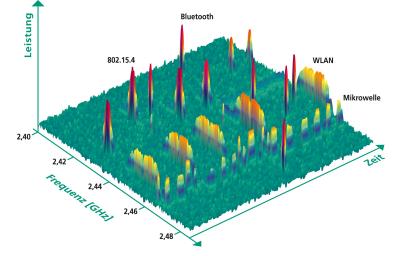Dec 6 2012
Wireless communication technologies have become an indispensable part of industrial operations. Within the logistics sector, for instance, Wi-Fi and Bluetooth are used not only to identify and track goods but also to control forklift trucks or high-rack storage systems.
 “Awair” displays when signals are being transmitted and on which frequencies. Credit: © Fraunhofer ESK
“Awair” displays when signals are being transmitted and on which frequencies. Credit: © Fraunhofer ESK
In this, the various wireless systems are obliged to share a single frequency band. To ensure that all runs smoothly, coexistence planners monitor both the wireless systems and potential intruders, since any interruption to the transmission of data could cripple production. In "Awair", researchers at the Fraunhofer Institute for Communication Systems ESK in Munich have developed a piece of software whereby coexistence planners will be able not only to detect available radio frequencies but to predict them, too.
"Awair" draws up a digital map of available wireless channels, displaying channel usage in the form of a 3-D image. As on a physical map, the visual representations form hills and troughs; bulges in the 3-D image signify that a frequency is in use, while unaltered areas indicate an available one. Using recorded data to construct time series, it is also possible to forecast which channels will be used when, and for how long. This gaze into the future is the product of neural networks. This refers to a series of technologies that approximate the way the human nervous system processes information. These technologies analyze time series data, allowing them to predict which frequencies are available with unerring accuracy, all correct to the nearest second.
Tighter rules in coexistence management
"Companies can use "Awair" to ensure they comply with increasingly strict industry standards. Just recently, the European Telecommunications Standards Institute (ETSI) published a new, amended standard dealing with the fair use of wireless communication channels. The standard brings with it greater challenges in the area of coexistence management. In particular, it restricts the choice of frequency bands available to automated manufacturing systems that need to communicate with one another in real time", outlines Dipl.-Ing. Günter Hildebrandt of Fraunhofer ESK.
To ensure that all unlicensed radio frequency bands can be monitored, Fraunhofer ESK researchers decided on flexible, software-based technologies like software-defined radio (SDR) and neural networks, tailoring them to the needs of industry. In contrast to the standard radio chip, which uses hardware to process radio signals, SDR systems use software instead. As a result, SDR is more flexible – simple adjustments in the software allow a single wireless device to use multiple radio frequency bands.
Across the world, radio frequencies are divided up into licensed and unlicensed bands. In Germany, this is the responsibility of the Federal Network Agency, while the International Telecommunication Union (ITU) forms the corresponding international body. In Europe, considerations of cost mean that companies in the industrial sector mainly use the popular and unlicensed 868 MHz, 2.4 and 5 GHz ISM radio frequency bands. But it's not only industry competing for use of these radio bands, but private households too. As a result, bottlenecks and overloaded frequency bands are a daily occurrence.